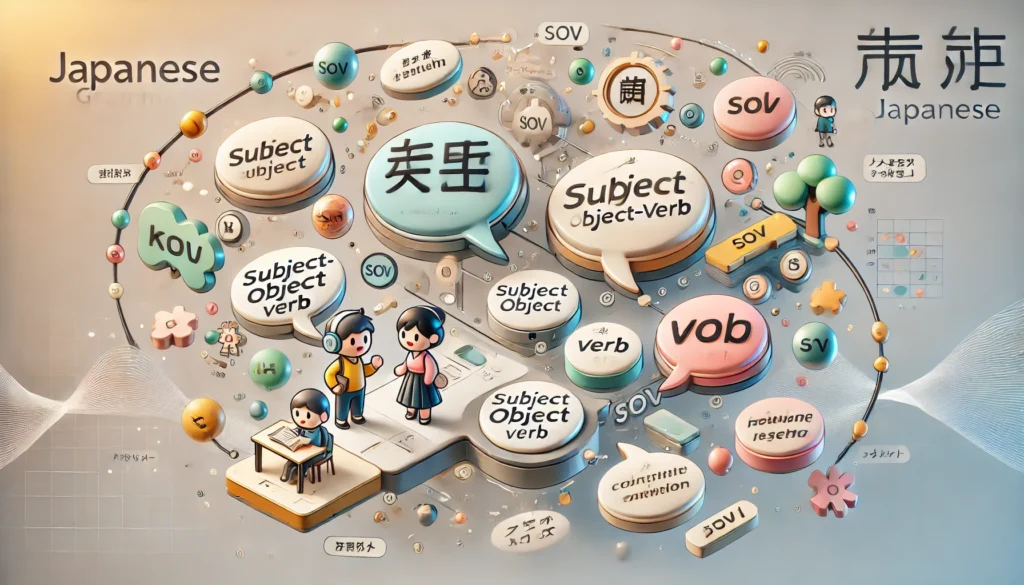Understanding Japanese Grammar as a Beginner
Learning Japanese can seem overwhelming at first, but understanding a few key grammar rules will help you build a strong foundation. While Japanese grammar differs from English, once you grasp its structure, it becomes logical and predictable.
In this guide, we’ll break down Japanese grammar rules beginners must know to help you start forming sentences and speaking naturally. By the end, you’ll have a better understanding of sentence structure, particles, verb conjugations, and more. Let’s dive into the essentials of Japanese grammar!
Japanese Sentences Follow a Subject-Object-Verb Order
Unlike English, where the sentence order is subject-verb-object (e.g., “I eat sushi”), Japanese follows a subject-object-verb (SOV) pattern:
- English: I eat sushi.
- Japanese: 私は寿司を食べます。
(Watashi wa sushi o tabemasu.)
(Literal translation: I sushi eat.)
This word order is a fundamental difference in Japanese grammar rules beginners must know, but with practice, it will start to feel natural.
Particles Define Sentence Meaning
Particles (助詞 joshi) are small words that indicate the function of words in a sentence. Some of the most commonly used particles include:
- は (wa) – Indicates the subject/topic
- 私は学生です。(Watashi wa gakusei desu.) → “I am a student.”
- が (ga) – Marks the subject when emphasizing it
- 彼が先生です。(Kare ga sensei desu.) → “He is the teacher.”
- を (o) – Marks the direct object
- 本を読みます。(Hon o yomimasu.) → “I read a book.”
- に (ni) – Indicates time or place
- 学校に行きます。(Gakkou ni ikimasu.) → “I go to school.”
- で (de) – Marks the place where an action occurs
- レストランで食べます。(Resutoran de tabemasu.) → “I eat at a restaurant.”
Mastering particles is essential for forming grammatically correct sentences.
Japanese Verbs Come at the End
Japanese verbs always appear at the end of the sentence. For example:
- I will go to Tokyo.
東京に行きます。 (Tokyo ni ikimasu.) - She drinks coffee.
彼女はコーヒーを飲みます。 (Kanojo wa koohii o nomimasu.)
Even in longer sentences, the verb remains at the end.
There Is No Plural Form in Japanese
Unlike English, Japanese nouns generally do not change between singular and plural:
- 猫 (neko) can mean “cat” or “cats” depending on the context.
- 本 (hon) can mean “book” or “books.”
To specify multiple items, Japanese uses counters or words like たち (-tachi) to indicate plurality for people and living things:
- 子供たち (kodomo-tachi) – “Children”
- 先生たち (sensei-tachi) – “Teachers”
Japanese Adjectives Also Conjugate
In Japanese, adjectives function similarly to verbs and change their form based on tense. There are two main types:
i-Adjectives (い形容詞)
These adjectives end in -い and change form when conjugated:
| English | Present | Past | Negative (Present) | Negative (Past) |
|---|---|---|---|---|
| Hot | 暑い (atsui) | 暑かった (atsukatta) | 暑くない (atsukunai) | 暑くなかった (atsukunakatta) |
na-Adjectives (な形容詞)
These adjectives end in -な when modifying a noun, but use です (desu) in polite sentences:
| English | Present | Past | Negative (Present) | Negative (Past) |
|---|---|---|---|---|
| Quiet | 静かです (shizuka desu) | 静かでした (shizuka deshita) | 静かではありません (shizuka de wa arimasen) | 静かではありませんでした (shizuka de wa arimasen deshita) |
Understanding adjectives is crucial for forming descriptive sentences.
Japanese Uses Different Levels of Politeness
Japanese has multiple levels of formality, with casual, polite, and formal (敬語 keigo) speech styles.
- Casual: Used with close friends and family
- 行く?(Iku?) → “Going?”
- Polite: Used in daily interactions
- 行きます。(Ikimasu.) → “I will go.”
- Formal/Respectful: Used in business or speaking to superiors
- いらっしゃいます。(Irasshaimasu.) → “They will go.” (Honorific)
For beginners, focusing on polite ます (-masu) and です (desu) forms is the best starting point.
Japanese Has No Future Tense
Japanese does not have a separate future tense. Instead, context determines whether a sentence refers to the present or future:
- 本を読みます。 (Hon o yomimasu.) → “I read a book” / “I will read a book.”
If you want to clarify that something will happen in the future, you can add time expressions:
- 明日学校に行きます。 (Ashita gakkou ni ikimasu.) → “I will go to school tomorrow.”
Questions Are Formed with か (ka)
To turn a statement into a question, simply add か (ka) at the end:
- あなたは日本人ですか? (Anata wa nihonjin desu ka?) → “Are you Japanese?”
- これは何ですか? (Kore wa nan desu ka?) → “What is this?”
Unlike English, Japanese does not require changing word order or adding auxiliary verbs.
Pronouns Are Often Omitted
Japanese often omits pronouns when context makes them unnecessary:
- (私は) 寿司が好きです。 (Sushi ga suki desu.) → “I like sushi.”
- (あなたは) 元気ですか? (Genki desu ka?) → “How are you?”
Unless clarification is needed, Japanese speakers usually leave out pronouns.
The Difference Between は (wa) and が (ga)
Beginners often struggle with は (wa) and が (ga), but understanding their differences makes sentence structure clearer:
- は (wa) emphasizes the topic:
- 猫はかわいいです。(Neko wa kawaii desu.) → “Cats are cute.” (General statement)
- が (ga) emphasizes the subject:
- この猫が好きです。(Kono neko ga suki desu.) → “I like this cat.” (Specifying the subject)
Final Thoughts: Mastering Japanese Grammar Basics
These Japanese grammar rules beginners must know will help you start constructing sentences with confidence. As you continue learning, practice by listening to Japanese conversations, reading simple texts, and applying grammar in daily use.
If you’re serious about improving your Japanese, check out Wakoku’s beginner guides for structured lessons on grammar, vocabulary, and sentence building!
With consistent practice, these rules will become second nature, helping you progress toward fluency. 頑張ってね! (Ganbatte ne!) – “Good luck!”




